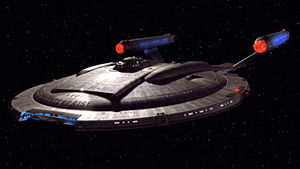Star Trek: Enterprise
Star Trek: Enterprise (often abbreviated ENT) is a roundly panned series that was canceled after just four seasons instead of being allowed to achieve the "traditional" seven seasons that every Star Trek show has done since Star Trek: The Next Generation.
Controversies
The Akiraprise
The Enterprise (NX-01) design was roundly criticized for looking too much like the TNG-era Akira-class starships instead of the older ships that had been seen from time to time in various Trek shows.
Furthermore, despite pre-dating the original series, the ship had virtually all of the same technologies found in TOS and TNG, although some were arbitrarily renamed ("polarized hull plating" instead of "shields", for instance).
Continuity? What Continuity?
Another point of criticism was that the writers did not follow long-established Trek canon; instead making up history as they went along, often using contrived scenarios to justify introducing characters and concepts that had no place in a prequel.
Token Black Guy
Ensign Travis Mayweather soon became the series' Token Black Guy; he frequently failed to appear in episodes, and when he did, it was often to say a single line or just lurk in the background. His character was originally going to be a Lieutenant, but was demoted to ensign once a black man was cast.
The Temporal Cold War
The Temporal Cold War was a recurring plotline about unspecified future people trying to alter history by messing with the past. The plot thread never really went anywhere, and -- damningly -- not even the writers knew how this plotline would be resolved.
The Final Episode
The last televised episode of Enterprise, instead of following any story arcs that had been started earlier in the season, mostly featured TNG characters Riker and Troi, and featured them exploring a holodeck program featuring the Enterprise's adventures. The idea of the series' finale being devoted to characters from a completely different series pissed off fans and even the show's actors, and they were further angered when Tucker ended up getting a pointless off-screen death that a Red Shirt would be embarrassed to receive. Some have pointed to the holodeck program in the episode as proof that Enterprise is in fact itself a fictional show within the world of TNG-era Star Trek, which helps explain the many continuity errors in the series (although the final season had been making some effort to correct these errors).
Others consider the episode proof that Berman and Braga deliberately wanted to write a shitty send-off for Enterprise to spite the fans for not blindly watching the show... though if that was the idea, B&B managed to screw that up too, since the holodeck framing story made it easy for the various novelists who continued the Enterprise storyline after the show's cancellation to basically say "Yeah, that shitty episode never happened, just ignore it folks."
The Good
Starting from the late third season, the show's quality began to improve, mainly thanks to a new producer and changes in the writing staff. The fourth season is generally regarded as the show's best effort at living up to it's premise, garnering praise from both the fans and professional reviewers[1].
Also the ending of the last episode (These are the voyages...) was regarded as the best ending to any of the series.
http://uk.youtube.com/watch?v=pXotJu1CapU&feature=related
The Would-Be Season Five
There was originally going to a season five of Enterprise, however the show was cancelled by Paramount. Here are some of the ideas that were going to be in Season Five if it had been given the go:
- Shran becoming a crewmember on board Enterprise
- T'Pol learning her father was a Romulan agent posing as a Vulcan officer prior to faking his own death.
- Construction of the first Starbase around Berengaria VII
- The NX-01 visiting Ardanna.
- Seeing Denobula for the first time in the series.
- A sequel to In A Mirror Darkly.
